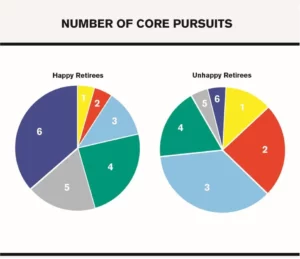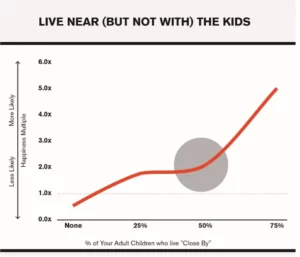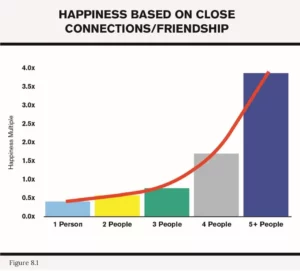by Wes Moss
The first step in securing a happy retirement is ensuring your financial ducks are in a row. But once they are, the job is not done. The happiest retirees accumulate ample retirement savings so they can focus on enjoying their lives. Put another way, a house not built on a stable foundation will crumble. But a stable foundation without a house on top is just a concrete slab.
Learning the Five Lifestyle Secrets Of The Happiest Retirees can help give folks a head start.
Habit #1: Happy Retirees Have An Average Of 3.6 Core Pursuits
A core pursuit is a hobby on steroids—an activity you’re passionate about that brings you excitement and fulfillment.
Based on a nationwide survey of roughly 1,350 retirees researched in writing You Can Retire Sooner Than You Think and What the Happiest Retirees Know, the happiest retirees average 3.6 core pursuits, whereas the unhappiest land at 1.9.

The happiest retirees average 3.6 core pursuits, whereas the unhappiest land at 1.9.
SOURCE: WHAT THE HAPPIEST RETIREES KNOW; CAPITAL INVESTMENT ADVISORS
You may already play tennis, fish, write poetry, and volunteer at a local soup kitchen. Congratulations—you’re above average! If not, don’t worry—it’s not too late to start. If you’re having trouble coming up with ideas, check out my Core Pursuit Finder. It quizzes you about preferences to narrow down your interests and generate suggestions.
A core pursuit doesn’t have to be anything outlandish. There’s probably someone out there who likes to hang glide and skydive, but it’s perfectly okay to prefer quilting or walking. What you do isn’t crucial, but doing nothing can be detrimental to your happiness. Core pursuits are building blocks for happiness during your post-career years.
The unhappiest folks tend to assume that not having to go to work is the recipe for a happy retirement. In truth, the more core pursuits you can identify before retirement, the smoother the transition will be once you finally have more free time.
Our research shows the four most popular core pursuits are travel, activities with family and grandkids, playing golf or tennis, and volunteering. Of the favorites, volunteering tops the list. As luck would have it, giving to others also offers considerable benefits to you—retirees who volunteer report much higher self-rated health scores than those who don’t.
Core pursuits are like happy retiree insurance. So whether it’s racquetball, squash, pickleball, tennis, bingo, bridge, pottery, or driving a school bus, dip your toe in and keep it there in case some of your other core pursuits need a break. That’s what happy retirees do.
Habit #2: Happy Retirees Live Near At Least 50% Of Their Adult Children
According to our research, retirees who live “near or close” to at least half their children are five times more likely to be happy. If you’re not close to them geographically and it’s feasible, consider moving. Your kids shouldn’t live with you, but at least half of them should live near you.
If your three kids live in Denver, Colorado, but you still live in Tampa, Florida, your focus should be on how to get to Denver over the next five years. Happy retirees have the flexibility and financial resources to make big decisions, including cross-country moves. By giving themselves greater freedom and security, they make room for greater joy.

BEVERLY HILLS, CALIFORNIA – JANUARY 18 : Winner Michael J Fox backstage at the 55th Annual Golden … [+]
GETTY IMAGES
Actor, author, and philanthropist Michael J. Fox once said, “Family is not an important thing, it’s everything.” He ought to know. After all, he got his Hollywood break on a show called Family Ties. But if that or Back to the Future isn’t your thing, maybe take a cue from Fast & Furious. No matter how many mistakes Vin Diesel makes or death-defying risks he takes, he never forgets how much he loves his family. If Vin can keep his family close, I can confidently say he’ll be a happy retiree when the fortieth sequel rolls around.

Retirees who live “near or close” to at least half of their children have been shown to be five … [+]
SOURCE: WHAT THE HAPPIEST RETIREES KNOW; CAPITAL INVESTMENT ADVISORS
Habit #3: Retirees Are 4.5 Times More Likely To Be Unhappy If They’re Unmarried
According to our research, retirees are 4.5 times more likely to be unhappy if unmarried.
I’m not here to pass judgment, nor am I a marriage counselor. But I do have an answer to the question, “Can I get a divorce and still be a happy retiree?” My research shows that you can get divorced without negatively impacting your retirement happiness—but only once. Everybody gets one marriage mulligan.
This sentiment might contrast with the typical portrait of the financially secure, happy retiree. The Millionaire Next Door is a legendary, best-selling book with many valuable lessons but doesn’t mention divorce. That type of omission often concerns money.
Jay Zagorsky, a research scientist at Ohio State University’s Center for Human Resource Research, writes, “Divorce causes a decrease in wealth that is larger than just splitting a couple’s assets in half.” Zagorsky’s study of about 9,000 people found that divorce reduces a person’s wealth by about 77%. On the other hand, it showed that being married almost doubled comparative wealth (93%).
There is an obvious cost, financial and emotional, of getting divorced. But is it devastating to retirement happiness? My research says no.
Of course, just as with all of the lifestyle secrets of the happy retirees, this one is meant to serve as a guideline, not a decree carved in stone. Plenty of folks are single and happy, but they need to be more intentional about maintaining support networks and friendships, staying active, connected, and socially engaged with their family of choice.
So whether you put a ring on it long ago, traded up for a second set of rings, or choose to fly solo, know that it’s still possible to retire early and happy.
Habit #4: Happy Retirees Have At Least Three “Close Connections”
Happy retirees have at least three “close connections” in the world, based on our research. This is someone who celebrates your good days and comforts you when times are tough. Social connection is crucial to survival. Those who might find this a bit too “touchy-feely” would do well to summon the wisdom of kangaroos.
Kangaroo care is a method used in certain hospitals where an infant, naked except for a diaper and cap, is placed on the bare chest of the mother or father for several hours at a time. The name derives from how an actual kangaroo holds its offspring cuddled close in a marsupial pouch. The technique was developed in Bogota, Colombia, in the late 1970s as a response to high death rates in premature infants. The doctors believed it could be drastically reduced if babies were held close to the bodies of their mothers for large portions of the day. They were right. These babies not only survived but thrived.
My friend and fellow author Dan Buettner is considered a pioneer in explaining the longevity and happiness of particular cultures. He says social connectedness plays a gigantic role. According to Dan, Americans had an average of three close friends in the 1980s. Today, with the prevalence of social media, digital “friends,” and more people moving to the suburbs, he says that number has dropped to an average of 1.7.

Happy retirees report to have at least three “close connections” in the world.
SOURCE: WHAT THE HAPPIEST RETIREES KNOW; CAPITAL INVESTMENT ADVISORS
“If you don’t have at least three friends who you can call up on a bad day and, let’s say, borrow money from,” Dan says, “it’s as bad for your health as a smoking habit. It shaves about eight years off your life expectancy.”
The crucial importance of social connection has repeatedly surfaced in my surveys, but being social isn’t an either-or situation where you either are or aren’t for all eternity. It’s something you can build up to and work on. Even the most social and extroverted humans must consciously find and maintain friends with similar interests, especially when they don’t have a ready-made network of colleagues and coworkers.
Habit #5: Retirees Are 1.5 Times More Likely To Be Happy If They Regularly Attend A Place of Worship
Based on our research, retirees are 1.5 times more likely to be happy if they regularly attend a place of worship. That can mean a church, synagogue, mosque, temple, or other, as long as you do it more often than not.
As part of my expanded survey, I asked thousands of retirees how frequently they attended services at their church or synagogue. The happiest retirees attend church on average once per week. Going less lowers happiness levels, whereas going more doesn’t raise them. There was a bare minimum when it came to annual attendance. Happy retirees go to church at least twice a year. Very doable. Even a guy like me with four kids and a radio show goes to church more than that.

Retirees appear 1.5 times more likely to be happy if they regularly attend a place of worship.
SOURCE: WHAT THE HAPPIEST RETIREES KNOW; CAPITAL INVESTMENT ADVISORS
Church can be a powerful way of building community. Losing access to social networks is one of the most significant risks during retirement. Even if you’re on the fence about what you believe, getting involved will give you access to a larger group of people doing good works.
It seems there is some power in faith. For thousands of years, people have found great comfort in believing in something greater than themselves. I don’t have survey data to suggest any particular religion increases retirement happiness more than others. However, there does seem to be a connection between happiness, having faith, and giving back. Maybe it doesn’t matter what we believe but how we believe it.
Finding the right church is like any other worthwhile endeavor—it requires effort. The church down the street from you might not be a fit, but perhaps the church ten miles down the highway is. Go where you feel the most welcome and where the people around you have similar beliefs and values. If America’s happiest retirees are any indication, you’ll be glad you did.
Bottom Line
The reason it’s crucial to study the happiest retirees is because they’re the ones with the answers. By learning what they’ve done and continue to do, future retirees can emulate and implement their own version of that behavior to increase their chances of happiness. The five lifestyle secrets are a road map marked with golden opportunities. Use it to chart your own course for happiness in retirement.
This information is provided to you as a resource for informational purposes only and is not to be viewed as investment advice or recommendations. This information is being presented without consideration of the investment objectives, risk tolerance, or financial circumstances of any specific investor and might not be suitable for all investors. This information is not intended to, and should not, form a primary basis for any investment decision that you may make. Always consult your own legal, tax, or investment advisor before making any investment/tax/estate/financial planning considerations or decisions. The views and opinions expressed are for educational purposes only as of the date of production/writing and may change without notice at any time based on numerous factors, such as market or other conditions.

